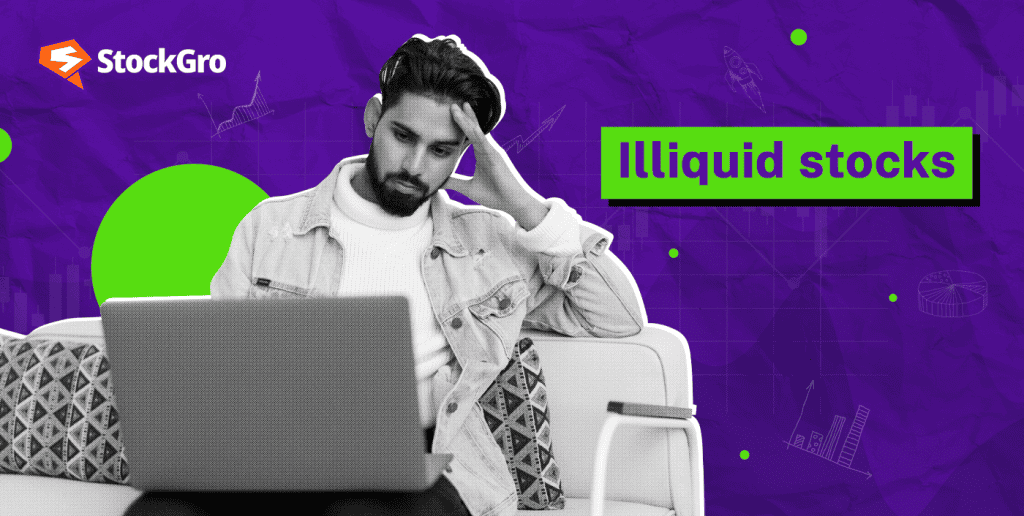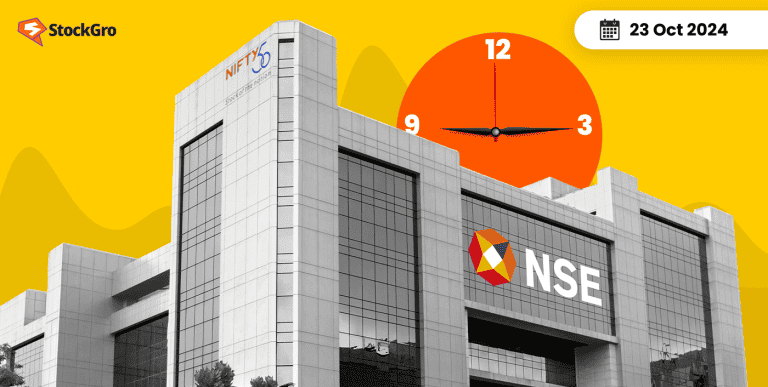
Stock markets run with the collaboration of various stakeholders such as investors, depositories, regulators, etc. Investors are the fuel for stock markets. Their buying and selling decisions result in price movements in the markets. Prices are negotiated through these actions, and trading volume is catalysed. Therefore, the volume of a stock market is a crucial factor in determining its size.
As of October 21, 2024, the registered investors on the National Stock Exchange (NSE) and Bombay Stock Exchange (BSE) are 20.1 crores and 19.5 crores respectively. The investment psychologies and perspectives of such a large base of investors clash to result in market price fluctuation.
However, when investors are not willing to buy or sell in a specific stock, there is a lack of trading volume. Such stocks are generally referred to as illiquid stocks. They are considered perilous, but with appropriate strategies they can help investors tap the potential gains. Let’s explore what is an illiquid stock and its investment strategies.
What are illiquid stocks?
‘Illiquid stocks’ are quite a popular term in the market. However, few know about their innate features and trading opportunities in the market. The stocks which do not have sufficient liquidity in the market are known as illiquid stocks.
The market functions on a zero-sum game. For every buy order, there needs to be a seller who can match the order conditions. However, in the illiquid stocks, these orders are not matched, and the wide difference is evident. Illiquid stocks are risky, but they can provide potential diversification for an investor.
Also, read this: Top 5 high-yield investment opportunities and risks
How to identify illiquid stocks?
When an investor encounters some of the following features in a stock, it can indicate the potential illiquidity in that stock.
- Volume – It is a key indicator for illiquid stocks. The investors may not find buyers for their asked prices. Institutional investors may also avoid investing in such stocks.
- Wide price spread – The bid-ask spread (buy order price-sell order price) is very high in such situations. The spread may also heavily fluctuate in such stocks.
- Market fluctuations – When a stock is illiquid, and sellers are waiting to find the buyer, it may heavily fluctuate when the buyers return. In such a scenario, the stock may also explore the market lows due to selling pressure.
- Period call auction notification – The market regulator, the Securities Exchange Board of India (SEBI), has prescribed criteria for illiquidity classification. Exchanges check these conditions and release a list of illiquid stocks at the start of the quarter. Investors may check this list or get a notification during the trading procedure.
Market fluctuations are a regular phenomenon, and during this, stocks may become illiquid temporarily due to a lack of demand. However, if such illiquid conditions are persistent, the stock is monitored by the exchange.
Periodic call auctions by SEBI
Consistent illiquidity in a stock for a considerable span may cause frequent heavy market fluctuations, which can potentially be a significant risk for investors. SEBI has prescribed norms for classifying such stocks and trading them separately through the periodic call auction mechanism. The core objective of this reform was to safeguard investors from heavy volatility in the market and provide a facility for price discovery.
The stock exchanges would monitor stocks and classify them as illiquid at the start of every quarter. The criteria for this classification are checked for a quarter as follows:
- Average trading volume < 10,000 shares per day
- Average daily trades < 50
- Such stock will be illiquid on all the exchanges.
- If a stock remains in this mechanism for a minimum of two quarters and does not show an illiquid nature (as mentioned above), then it will be transferred to a regular trading setting.
- Notification for such classification and removal of stocks in the illiquid stocks list would be released by the exchanges.
In the period stock auction mechanism, stocks will be traded in sessions of one hour each starting from 9:30 A.M. In these sessions, a fixed procedure will be followed as follows:
- First 45 minutes, traders can place the orders for the required script.
- Next 8 minutes, the placed orders will be matched.
- The remaining 7 minutes are known as the buffer period. After this period, the next session starts.
The spaced arrangement of sessions helps process orders with required care and avoid fluctuations. A maximum 20% price spread is decided for orders, which can be lowered in case of regulatory measures. When an investor places an order equal to or more than this price limit of 20% and if such trade is executed, a penalty is charged.
Strategies to invest in illiquid stocks
Illiquid stocks are considered dangerous, but they can provide the desired diversification for the portfolio. A stock in holding may become illiquid temporarily, or investors have to trade a stock under periodic call auction. In such scenarios, the investors can use the following strategies:
- Long-term investments: Investors with a long-term perspective may not be significantly affected by such temporary market volatility. The stocks may become stable or appreciated after such a period. One should check the fundamental soundness of such stocks.
- Limit order: Investors can opt for limit orders rather than regular market orders. These have the facility to decide a price for placing orders, and investors can be at peace with price volatility up to some extent.
- Constant research and analysis: The exchanges monitor stocks for one quarter before classifying them as liquid. During this period, investors can keep track of price actions of such stocks. It can help them plan required exits.
- Diversification: If the stock fundamentals are strong in holistic prospects, investors can hold them, and it will provide them with diversification benefits.
An interesting read: What Is a Limit Order in Trading, and How Does It Work?
Risks of illiquid stocks
Investors should consider the following risks accompanied by illiquid stocks while trading or holding them after they become illiquid.
- Transaction cost: Brokerage firms may charge higher transaction fees in periodic call auctions or holding illiquid stocks. Investors should check these norms with their brokers before investing.
- Price fluctuations: The prices may be volatile to frequent entry and exit of buyers.
- Regulatory risk: If any manipulation or malpractice is found in such stock, then the regulator may take required actions or delist the company.
- Opportunity cost: Illiquid stocks may take considerable time to function normally, and an investor’s funds may get stuck. This investor may miss alternate investment opportunities.
Conclusion
Illiquid stocks are the ones with a lack of ample buyers and a wide price spread in the market. Investing in such stocks can be risky. However, with conscious monitoring and application of suitable strategies, investors can reap its benefits.
FAQs
- What does it mean if a stock is illiquid?
In layman’s terms, it is a state when stocks don’t have ample buyers and the price difference between the bids and asks is significant. Usually, these stocks are avoided by the institutional investor due to their sudden volatility. However, this illiquid situation may be temporary for some stocks and investors with long-term perspectives may not be affected by it.
- What is the risk of illiquid stocks?
The key risk is the lack of buyers for the stock. Due to volume issues, the prices have wide differences (also a reason for not finding buyers). When volume returns, the prices may heavily fluctuate. Moreover, the broker may charge extra costs for trading in illiquid stocks as it has separate norms and sessions.
- How to know if a stock is illiquid?
Volume is a crucial indicator for gauging liquidity in a stock. When there is a vast difference between the bids and ask prices. Moreover, the volume of stock for both sides would be low for some days in such stocks. Institutional investors are not in action for these stocks, or returns are lower. Illiquid stocks may also hit lows for some days.
- Are illiquid investments good?
These are stocks with a lack of required volume and may pose a significant level of liquidity risk. Investors can get stuck at the unwanted price points. However, investors with a long-term perspective may not be bothered because liquidity can be a temporary situation. Moreover, investors with enough market knowledge can exercise this investment.
- How can limit order strategy for illiquid stocks?
Limit orders can be a suitable strategy for investors willing to buy or sell stocks at a particular price. Illiquid stocks may not have volume for a short span and may experience fluctuations after that. During this time, limit orders can help exercise the required control. Investors can use limit orders to avoid buying illiquid stocks at inflated prices or selling at discount.

